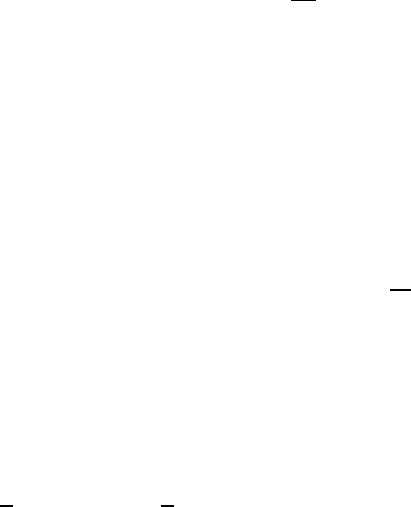Escher J., Guidotti P., Hieber M. et al. (editors) Parabolic Problems: The Herbert Amann Festschrift
Подождите немного. Документ загружается.


708 G. Str¨ohmer
and
σ
e
= {z ∈ C | there is a U ∈ D (L) \{0} with LU = zU}
for the set of eigenvalues of L.
We prove that spectral stability implies dynamic stability, i.e., that the ab-
sence of eigenvalues of the formal linearization with non-negative real part implies
the non-linear stability of the equilibrium. In addition, for constant equilibria and
for the functions F and G given in (1.7) we reproduce the result of Chen, Friedman
and Hu that Conditions 1 and 2 imply stability. We work in Sobolev spaces W
k
p
with p>3. To be precise, we prove
Theorem 1.1. Assume that
σ
e
∩{z ∈ C | Re (z) ≥ 0} = Ø. (1.10)
Then there is a number η>0 such that if ϕ
0
∈ W
3
p
and v
0
∈ W
1
p
and ϕ
0
W
3
p
+
v
0
W
1
p
≤ η, then there exists a unique solution (v, ϕ) of equations (1.9) for
t ∈ [0, ∞) such that v ∈ C
0
[0, ∞) ,W
1
p
(Ω)
∩ C
1
([0, ∞) ,L
p
(Ω)), ϕ ∈ C
0
[0, ∞) ,W
3
p
(Ω)
∩ C
1
[0, ∞) ,W
1
p
(Ω)
,
∂ϕ
∂n
=0and ϕ (0) = ϕ
0
, v (0) = v
0
.Also
ϕ (t)
W
3
p
+ v (t)
W
1
p
→ 0 as t →∞.
Condition (1.10) is implied by Conditions 1 and 2 if F and G are either indepen-
dent of x or of the form given in equations (1.7).
The system (1.2) is similar to the equations for viscous compressible fluids in
that it combines a hyperbolic equation with a parabolic one. Therefore it seems
reasonable to transform the equations into Lagrange coordinates produced by the
vector field ∇φ. Doing this, we encounter the problem that if we control k spatial
derivatives of φ, we only control k − 1 derivatives of the Lagrange coordinates
and therefore k − 2 of those of the transform of the normal n, leading to a priori
estimates of only k − 1 derivatives of φ.Thuswehavealossofregularity,which
does not occur in the original coordinates. To avoid this we will transform the
dependent variables in our problem.
2. Notation
Let Ω ⊂ R
n
be a domain. By L
p
(Ω)wedenoteforp ∈ (1, ∞)thesetofall
measurable real (or complex, the distinction will usually not cause any difficulty)
functions for which the pth power of their absolute value is integrable, by W
k
p
(Ω)
for integer k>0 and again p ∈ (1, ∞) the subset of L
p
(Ω) of all functions having
distributional derivatives up to order k belonging to L
p
(Ω) also. If the set is the
domain Ω mentioned above, it is usually omitted. If B is any Banach space, we
denote by C
k
(Ω,B)thesetofallk-times continuously differentiable functions
from Ω to B,byC
k
Ω,B
the subset of functions for which all these derivatives
have a continuous extension to Ω.

Stability for a Parabolic-hyperbolic System 709
3. Local existence
We will first show that for given initial values a solution exists for a time interval
of a length going to infinity as the size of the initial values goes to zero. A similar
result in H¨older spaces was already proved in [3]. There is not much genuinely new
in this section, the point is just to state precisely what we need here and give an
outline of a proof. We confine ourselves to initial values such that ϕ
0
∈ W
3
p
,
∂ϕ
0
∂n
=0
and v
0
∈ W
1
p
.
The operator Δ with the boundary conditions
∂ϕ
∂n
= 0 generates an analytic
semigroup on the space L
p
(Ω) with the domain of definition
D (Δ) =
ϕ ∈ L
p
(Ω) | ϕ ∈ W
2
p
(Ω) ,
∂ϕ
∂n
=0
.
We will prove the existence of a solution by a fixed point argument in the space
B
2
=
(v, ϕ) | v ∈ C
0
[0,T] ,W
1
p
(Ω)
∩C
1
([0,T] ,L
p
(Ω)) ,
ϕ ∈ C
0
[0,T] ,W
3
p
(Ω)
∩ C
1
[0,T] ,W
1
p
(Ω)
with the norm
(v, ϕ)
2
=max
0≤t≤T
v (t)
W
1
p
+ v
t
(t)
L
p
+ ϕ (t)
W
3
p
+ ϕ
t
(t)
W
1
p
.
The result is the following.
Theorem 3.1. There is a positive number C such that if
η = ϕ
0
W
3
p
+ v
0
W
1
p
and
∂ϕ
0
∂n
=0, then a unique solution (v, ϕ) of the system (1.9) exists on any
interval [0,T] with T ≤−C − C
−1
log (η) if this number is positive. In addition
then
(v, ϕ)
2
≤ Ce
CT
η ≤ 1
and if T ≥ 1,thenalso
ϕ (T )
W
3
p
≤ C
1
(ϕ, v)
C
0
(
[T −1,T ],W
1
p
)
+ (ϕ
t
,v
t
)
L
p
([T −1,T ]×Ω)
2
.
Proof. To reformulate our problem as a fixed-point equation let us assume (v, ϕ) ∈
B
2
and (v, ϕ)
2
≤ 1. Then we define (v, ϕ) as the solution of the system of
equations
v
t
+ ∇v∇ϕ = −∇u
∗
∇ϕ +
G (v, ϕ, x) −(v + u
∗
)Δϕ = g,
ϕ
t
− Δϕ =
F (v, ϕ, x)
(3.1)
with the initial values ϕ (0) = ϕ
0
,v(0) = v
0
. We can differentiate the second
equation with respect to time and obtain for f = ϕ
t
that
f
t
− Δf =
F
v
(v, ϕ, x) v
t
+
F
ϕ
(v, ϕ, x) ϕ
t
,

710 G. Str¨ohmer
which implies by standard estimates for semigroups – a fairly abstract and general
version is contained in Theorem 5.2.1. in [1] – that
f (t)
W
1
p
≤ C
ϕ
0
W
3
p
+ v
0
W
1
p
+ Ct
1/2
(v, ϕ)
2
and therefore
ϕ (t)
W
3
p
+ ϕ
t
(t)
W
1
p
≤ C
ϕ
0
W
3
p
+ v
0
W
1
p
+ Ct
1/2
(v, ϕ)
2
by standard elliptic estimates. (See, among many others, [2].) Introducing charac-
teristic coordinates by
dT
t
dt
= ∇ϕ (T
t
(x) ,t) ,T
0
(x)=x,
we obtain
T
t
W
2
p
+
#
#
T
−1
t
#
#
W
2
p
≤ C (T ) (v, ϕ)
2
. (3.2)
Therefore also
g ◦ T
t
W
1
p
≤ C (T ) (v, ϕ)
2
(for the definition of g see equations (3.1)) and
v
t
(t)
L
p
+ v (t)
W
1
p
≤ C v
0
W
1
p
+ TC(T ) (v, ϕ)
2
with an increasing function C (T ). We therefore have
(v, ϕ)
2
≤ C
1
ϕ
0
W
3
p
+ v
0
W
1
p
+ T
1/2
C (T ) (v, ϕ)
2
,
where C (T ) now denotes a different increasing function. If we make T = T
0
so
small that T
1/2
0
C (T
0
) ≤ 1/2 and then restrict the initial values by the inequality
ϕ
0
W
3
p
+ v
0
W
1
p
≤
1
2C
1
= η
1
,
the mapping taking (v, ϕ)to(v, ϕ) maps the ball (v, ϕ)
2
≤ 1toitself.Itisalso
easy to see that at least sufficiently high powers of the mapping are contractions
in lower-order norms, and thus it has a unique fixed point. Also with C
2
=2C
1
we have
ϕ (t)
W
3
p
+ v (t)
W
1
p
≤ C
2
ϕ
0
W
3
p
+ v
0
W
1
p
for t ∈ [0,T
0
]. If the initial value was small enough we can repeat this process, and
we then obtain the existence of a solution on the interval [0,T
0
k]ifηC
k−1
2
≤ η
1
and the inequality
ϕ (t)
W
3
p
+ v (t)
W
1
p
≤ C
k
2
ϕ
0
W
3
p
+ v
0
W
1
p
for 0 ≤ t ≤ T
0
k. From this we can easily derive our claims with the exception of
the last inequality. To obtain that inequality, observe that the right-hand side of
the equation for ϕ belongs to C
1/2
([T − 1,T] ,L
p
) and this norm can be estimated
by the right-hand side above. Using Theorem 2.5.3, Section III in [1], we then have
that ϕ
C
1/2
(
[T −1/2,T ],W
2
p
)
is bounded. Then we can differentiate the equation with
respect to t and use the usual parabolic estimates to get ϕ
t
W
2,1
p
([T −1/3,T ]×Ω)
and
Stability for a Parabolic-hyperbolic System 711
therefore ϕ
t
(t)
W
2−2/p
p
for t ∈ [T − 1/4,T] is bounded. (See, e.g., Theorem 7.20
in [9].) Using standard elliptic estimates, we can then obtain our claims.
4. Long term existence and stability
Throughout the following calculations we assume that (v, ϕ)
2
≤ 1. In this sec-
tion we will prove a priori estimates for small solutions of the equations (1.2) by
considering them as solutions of the inhomogeneous version of the linearized equa-
tions (1.8). They are not particularly hard to solve, but in switching to Lagrange
coordinates, as was already indicated, if we do not look at the non-linear problem
from the right angle, we have a loss of regularity. In order to avoid this problem,
we transform the equation, using the second equation in (1.9) to remove u
∗
Δϕ
from the first. Then we have
v
t
+ ∇v∇ϕ = −∇u
∗
∇ϕ +
G (v,ϕ, x) − u
∗
ϕ
t
−
F (v, ϕ, x)
− vΔϕ,
ϕ
t
−Δϕ =
F (v, ϕ,x) .
(4.1)
This leads to the equations
(v + u
∗
ϕ)
t
+ ∇(v + u
∗
ϕ) ∇ϕ
= ∇(u
∗
ϕ) ∇ϕ −∇u
∗
∇ϕ +
G (v, ϕ,x)+u
∗
F (v, ϕ, x) − vΔϕ,
ϕ
t
− Δϕ =
F (v, ϕ, x) ,
suggesting the definition w = v + u
∗
ϕ. With these new variables the equilibrium
in question is still located at w =0,ϕ=0, and for (w, ϕ)wehavetheequations
w
t
+ ∇w∇ϕ
= −∇u
∗
∇ϕ + u
∗
|∇ϕ|
2
+ ϕ∇u
∗
∇ϕ
+
G (w −u
∗
ϕ, ϕ, x)+u
∗
F (w − u
∗
ϕ, ϕ, x) − (w − u
∗
ϕ)Δϕ,
ϕ
t
− Δϕ =
F (w − u
∗
ϕ, ϕ, x) .
(4.2)
Letting
G (P, w, ϕ, x)=u
∗
|P |
2
+ ϕ∇u
∗
P +
G (w −u
∗
ϕ, ϕ, x)+u
∗
F (w − u
∗
ϕ, ϕ, x)
and
F (w, ϕ, x)=
F (w − u
∗
ϕ, ϕ, x)
we obtain
w
t
+ ∇w∇ϕ = −∇u
∗
∇ϕ + G (∇ϕ, w, ϕ, x) − (w − u
∗
ϕ)Δϕ,
ϕ
t
+ |∇ϕ|
2
−Δϕ = F (w, ϕ, x)+|∇ϕ|
2
.
(4.3)
Let us define
A (x)=G
w
(0, 0, 0,x) ,B(x)=G
ϕ
(0, 0, 0,x) ,
C (x)=F
w
(0, 0,x) ,D(x)=F
ϕ
(0, 0,x)

712 G. Str¨ohmer
and
R
1
= u
∗
|∇ϕ|
2
+ ϕ∇u
∗
∇ϕ − (w − u
∗
ϕ)Δϕ + G (0,w,ϕ,x) − A (x) w − B (x) ϕ,
R
2
= F (w, ϕ, x) − C (x) w − D (x) ϕ + |∇ϕ|
2
.
Then
R
1
W
1
p
≤ C
w
2
W
1
p
+ ϕ
2
W
2
p
+ Δϕ
2
W
1
p
,
R
2
L
p
≤ C
ϕ
2
W
1
2p
+ w
2
L
2p
and
w
t
+ ∇w∇ϕ = −∇u
∗
∇ϕ + A (x) w + B (x) ϕ + R
1
,
ϕ
t
+ ∇ϕ∇ϕ −Δϕ = C (x) w + D (x) ϕ + R
2
.
(4.4)
Now we introduce Lagrange coordinates by
T
t
(y)=∇ϕ (T
t
(y) ,t) ,T
0
(y)=y.
Then let w (y, t)=w (T
t
(y) ,t)and
∇
T
(f ◦T
t
)=(∇f ) ◦ T
t
,L
t
(f ◦T
t
)=Δf ◦ T
t
.
We refrain from stating the exact form of these differential operators, although
they will be needed later in the proof, but we leave these calculations to the
reader. Then, in these new coordinates, equation (1.9) is equivalent to
w
t
= −∇
T
u
∗
∇
T
ϕ +
A w +
B ϕ +
R
1
,
ϕ
t
−L
t
ϕ =
C (x) w +
D (x) ϕ +
R
2
.
(4.5)
This is why we consider the evolution equation
w
t
= −∇
T
u
∗
∇
T
ϕ +
A w +
B ϕ,
ϕ
t
−L
t
ϕ =
D ϕ +
C w
(4.6)
with the boundary values
n ·∇
T
ϕ =0.
We will find out that this is now accessible to arguments considering this as a
perturbation of the equation
w
t
= −∇u
∗
∇ϕ + A w + B ϕ,
ϕ
t
− Δ ϕ = D ϕ + C w
(4.7)
with boundary condition
∂ ϕ
∂n
=0.Wenowomitthein the notation. We want to
show we can use the theory of analytic semigroups by studying the operator
A
.
w
ϕ
/
=
.
−∇u
∗
∇ϕ + Aw + Bϕ
Δϕ + Dϕ + Cw
/
.
Then A : D (A) → B with
B =
U =
.
w
ϕ
/
| w ∈ W
1
p
,ϕ∈ L
p

Stability for a Parabolic-hyperbolic System 713
and
D (A)=
.
w
ϕ
/
∈ B | ϕ ∈ W
2
p
,
∂ϕ
∂n
=0
.
Then equation (4.7) becomes U
t
= AU and we have the following result.
Lemma 4.1. Assume that no z with Re (z) ≥ 0 is an eigenvalue of A. Then this
half-plane belongs to the resolvent set of A and there exists a number C such that
#
#
#
(zI − A)
−1
#
#
#
L(B)
≤ C (1 + |z|)
−1
for z with Re (z) ≥ 0. There also is an ε>0 such that
exp (tA)
L(B)
≤ Ce
−εt
.
Proof. First we prove the resolvent estimate. If
zU − AU = F =
5
F
1
F
2
6
T
,
then
(z − A) w = −∇u
∗
∇ϕ + Bϕ + F
1
,
zϕ − Δϕ = Dϕ + Cw + F
2
(4.8)
We have
A =
∂G
∂w
(0, 0, 0,x)=
∂
G
∂v
(0, 0,x)+u
∗
∂
F
∂v
(0, 0,x)
=
∂G
∂u
(u
∗
,φ
∗
,x)+u
∗
∂F
∂u
(u
∗
,φ
∗
,x)=a + cu
∗
< 0,
thus
A = a + cu
∗
(4.9)
and max
x∈Ω
A (x) < 0. From the first equation in (4.8) for Re (z) ≥ 0
w =(z −A)
−1
(−∇u
∗
∇ϕ + Bϕ + F
1
) (4.10)
and
zϕ − Δϕ = Dϕ + C (−∇u
∗
∇ϕ + Bϕ + F
1
)(z − A)
−1
+ F
2
.
From standard elliptic estimates we then obtain
ϕ
W
2
p
+ |z|ϕ
L
p
≤ C
ϕ
W
1
p
+ F
L
p
.
From equation (4.10) then
w
W
1
p
(1 + |z|) ≤ C
F
B
+ ϕ
W
1
p
.
This proves
#
#
#
(zI − A)
−1
#
#
#
L(B)
≤ C |z|
−1

714 G. Str¨ohmer
for large z. By standard compactness arguments one also has that if the only
solution of AU = zU is zero for all z with Re (z) ≥ 0, then the resolvent set
contains all such z and
#
#
#
(zI − A)
−1
#
#
#
L(B)
≤ C (1 + |z|)
−1
for such z. The existence of solutions for very large z is obvious in view of the
above considerations, and then it carries over to smaller z owingtotheestimates
we proved. The remainder is a consequence of, e.g., Theorem 2.1, Part II in [5].
Lemma 4.2. For U =
5
ϕv+ u
∗
ϕ
6
T
the equation AU = zU is equivalent to
zv = −∇u
∗
∇ϕ + av + bϕ − u
∗
Δϕ
and
zϕ =Δϕ + dϕ + cv.
Proof. Using equations (4.8) and (4.9) and remembering the definition of A, B, C,
and D in equations (4.4), this is an easy calculation.
Now we want to obtain the information we need about the long-term behavior
by considering the problem as a perturbation of this linearization. To do this we
also need to consider the equation
w
t
= −∇u
∗
∇ϕ + Aw + Bϕ + f
1
,
ϕ
t
− Δϕ = Dϕ + Cw + f
2
,
∂ϕ
∂n
= g on ∂Ω.
(4.11)
It is easy to show the following result.
Lemma 4.3. Assume f
1
belongs to L
p
(0,T) ,W
1
p
, f
2
to L
p
((0,T) ×Ω) and g to
W
1−1/p,1/2−1/2p
((0,T) × ∂Ω) as well as g (0) = 0. Then there is exactly one pair
of functions ϕ ∈ W
2,1
p
,w ∈ C
0
[0,T] ,W
1
p
with w
t
∈ L
p
((0,T) × Ω) fulfilling
equation (4.11) and ϕ (0) = 0, w (0) = 0 as well as the estimate
ϕ
W
2,1
p
+ w
C
0
(
[0,T ],W
1
p
)
+ w
t
L
p
((0,T )×Ω)
≤ C (T )
f
2
L
p
((0,T )×Ω)
+ g
W
1−1/p,1/2−1/2p
p
((0,T )×∂Ω)
+ f
1
L
p
(
(0,T ),W
1
p
)
.
Proof. For sufficiently short time intervals we can treat this system as a pertur-
bation of the single equations w
t
= f
1
and ϕ
t
− Δϕ = f
2
,
∂ϕ
∂n
= g.Thenwecan
continue step by step, also using the information about the operator A we already
derived. There we can use Theorem 5.4 in [8]. A proof can also be done in a similar
way to that of Theorem 13 in [10].
Now the solution ϕ, v constructed in Theorem 3.1 has the property that
(v, ϕ)
2
≤ C (T )
v (0)
W
1
p
+ ϕ (0)
W
3
p
.
We also have
T
t
−id
Ω
W
2
p
+
#
#
T
−1
t
−id
Ω
#
#
W
2
p
≤ C (T )
v (0)
W
1
p
+ ϕ (0)
W
3
p
.

Stability for a Parabolic-hyperbolic System 715
Thus
#
#
#
R
1
(t)
#
#
#
W
1
p
+
#
#
#
R
2
(t)
#
#
#
L
p
≤ C (T )
v (0)
W
1
p
+ ϕ (0)
W
3
p
2
,
it is also easy to see that the remaining error terms one has to incorporate into f
1
and f
2
to make w and ϕ solutions of (4.11) can be estimated in the same way. If
we write w and ϕ in the form w = w
1
+ w
2
and ϕ = ϕ
1
+ ϕ
2
where (w
1
,ϕ
1
)solve
equation (4.11) with f
1
= f
2
=0and(w
1
,ϕ
1
)(0) = (w
0
,ϕ
0
), while (w
1
,ϕ
1
)solve
equation (4.11) with the given f
1
and f
2
and (w
2
,ϕ
2
) (0) = 0, then combining
Lemmas 4.1, 4.2 and 4.3 we have
ϕ
W
2,1
p
((T −1,T )×Ω)
+ w
C
0
(
[T −1,T ],W
1
p
)
+ w
t
L
p
((T −1,,T )×Ω)
≤ C (T )
v
0
W
1
p
+ ϕ
0
W
3
p
2
+ Ce
−εT
ϕ
0
W
3
p
+ v
0
W
1
p
.
Then we can use the last inequality in Theorem 3.1, which one can easily see is
still true if we replace v by w, to obtain
ϕ(T )
W
3
p
+v(T )
W
1
p
≤C (T )
ϕ
0
W
3
p
+v
0
W
1
p
2
+Ce
−εT
ϕ
0
W
3
p
+v
0
W
1
p
.
For T so large that Ce
−εT
< 1/2 and initial values small enough to assure the
existence of a solution on [0,T]wethenhave
ϕ (T )
W
3
p
+ v (T )
W
1
p
≤
1
2
ϕ
0
W
3
p
+ v
0
W
1
p
+ C
ϕ
0
W
3
p
+ v
0
W
1
p
2
.
For sufficiently small initial values then
ϕ (T )
W
3
p
+ v (T )
W
1
p
≤
3
4
ϕ
0
W
3
p
+ v
0
W
1
p
.
This allows us to continue the solution indefinitely and implies that it converges
to zero as claimed. This concludes the proof of the first part of Theorem 1.1.
5. Excluding eigenvalues
For Re (z) ≥ 0wehavetoconcludev =0,ϕ=0from
.
zv
zϕ − Δϕ
/
=
.
−∇u
∗
∇ϕ + av + bϕ −u
∗
Δϕ
cv + dϕ
/
and
∂ϕ
∂n
= 0, where we have suppressed the variable x throughout. Solving the
lower equation for Δϕ we obtain
Δϕ =(z −d) ϕ − cv.
We can use this to replace Δϕ in the upper equation, which results in
zv = −∇u
∗
∇ϕ + av + bϕ −u
∗
((z − d) ϕ − cv) .
We assumed −a −u
∗
c>0, thus −a −u
∗
c + z =0, and we can solve for v to obtain
v =
b + u
∗
d −u
∗
z
z − a − u
∗
c
ϕ −
∇u
∗
∇ϕ
z − a − u
∗
c
.

716 G. Str¨ohmer
Replacing v in the second equation gives us
Δϕ =
ad − bc −z (a + d)+z
2
z − a − u
∗
c
ϕ +
c∇u
∗
z − a − u
∗
∇ϕ.
To duplicate the conditions of Chen, Friedman and Hu, we assume F and G do
not explicitly depend on x and neither does u
∗
, and D = ad−bc > 0,τ = a+d<0
and Γ = a + u
∗
c<0. If ϕ = 0 it has to be an eigenfunction of −ΔwithNeumann
boundary conditions for an eigenvalue λ
k
≥ 0, thus
D −τz + z
2
z − Γ
= −λ
k
and
−λ
k
Γ+D +(λ
k
− τ) z + z
2
=0.
This is an equation which cannot have any roots with a non-negative real part, as
−λ
k
Γ+D>0andλ
k
−τ>0.
For variable equilibria, considering the case with a variable δ we have
Γ=−δ, D = μδ, τ = −
μ
γ
δ
and therefore
Δϕ =
μδ + z
μ
γ
δ + z
2
δ + z
ϕ −
∇δ
δ + z
∇ϕ
and
div ((δ + z) ∇ϕ)=(δ + z)Δϕ + ∇δ∇ϕ =
μδ + z
μ
γ
δ + z
2
ϕ.
If we multiply the equation by ϕ and integrate over Ω, we obtain after an integra-
tion by parts that
−
Ω
(δ + z) |∇ϕ|
2
dx =
Ω
μδ + z
μ
γ
δ + z
2
|ϕ|
2
dx.
Therefore
Ω
μδ |ϕ|
2
+ δ |∇ϕ|
2
dx + z
Ω
μ
γ
δ |ϕ|
2
+ |∇ϕ|
2
dx + z
2
Ω
|ϕ|
2
dx =0.
If ϕ =0, we have a quadratic equation with only positive coefficients which again
cannot have a root in the half-plane described by Re (z) ≥ 0.
References
[1] Amann, H.: Linear and quasilinear parabolic problems, Volume I: Abstract linear
theory, Birkh¨auser, Basel, 1995.
[2] Browder, F.E.: Estimates and existence theorems for elliptic boundary value prob-
lems. Proc. Nat. Acad. Sci. U.S.A. 45 (1959) 365–372.
[3] Chen, X.; Friedman, A.; Hu, B.: A Parabolic-Hyperbolic Quasilinear System, Comm.
in PDE 33, 969–987.
Stability for a Parabolic-hyperbolic System 717
[4] Dalibard, A.L.; Perthame, B.: Existence of solutions of the hyperbolic Keller-Segel
model, Trans. Amer. Math. Soc. 361 (2009) 2319–2335.
[5] Friedman, A.: Partial differential equations, Holt, Rinehart, Winston, New York,
1969.
[6] Horstmann, D.: From 1970 until present: The Keller-Segel model in chemotaxis and
its consequences, Jahresber. Deutsch. Math.-Verein. 105 (2003) 103–165.
[7] Horstmann, D.: From 1970 until present: the Keller-Segel model in chemotaxis and
its consequences. II. Jahresber. Deutsch. Math.-Verein. 106 (2004) 51–69.
[8] Ladyzhenskaya, O.A.: Boundary value problems in mathematical physics III, Proc.
Steklov Inst. Math. 83 (1965).
[9] Lieberman, G.: Second order parabolic differential equations, World Scientific, River
Edge, N.J., 1996.
[10] Str¨ohmer, G.: Asymptotic estimates for a perturbation of the linearization of an
equation for compressible fluid flow, Studia math. 185 (2008) 99–125.
Gerhard Str¨ohmer
Department of Mathematics
University of Iowa
Iowa City
IA 52242-1419, USA
e-mail: gerhard-strohmer@uiowa.edu
